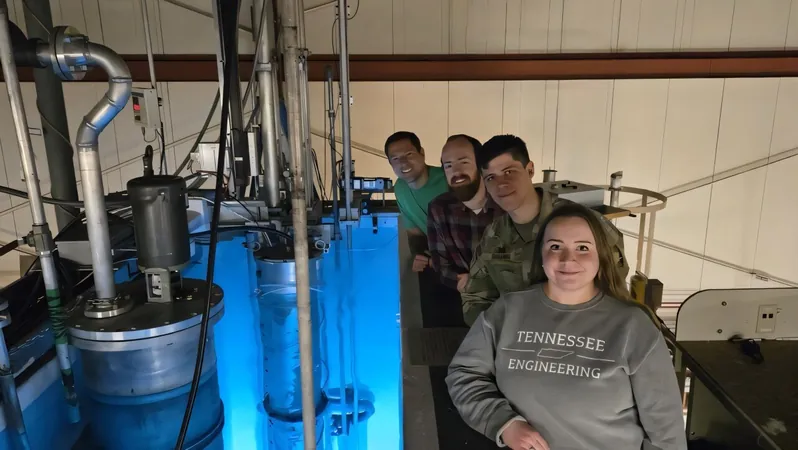
Breakthrough in Nuclear Rocket Fuel Testing Propels NASA’s Mars Plans Forward!
2025-04-02
Author: Daniel
Introduction
In an exciting development that could revolutionize space travel, a dedicated team from the Department of Energy's Oak Ridge National Laboratory (ORNL), accompanied by university students, recently conducted a groundbreaking experiment at The Ohio State University Research Reactor. Their focus: innovative coatings for nuclear thermal rocket fuel that could dramatically shorten NASA's astronaut journeys to Mars.
Significance of the Experiment
Brandon Wilson, a member of ORNL's Nuclear and Extreme Environment Measurement group, explained the significance of their work: “Our experiment aimed to test a fuel coating technique and assess its durability in the extreme conditions expected within a nuclear thermal rocket. This high-temperature testing is an essential milestone toward qualifying nuclear fuels for manned space missions.”
Nuclear Thermal Propulsion (NTP) Technology
Nuclear thermal propulsion (NTP), touted as a revolutionary technology for future crewed Mars missions planned for the 2040s, harnesses a nuclear reactor to heat hydrogen to unprecedented temperatures. The resulting heated hydrogen is expelled via a nozzle to create thrust, offering a far more efficient means of transport compared to traditional chemical rockets. Such technology promises not only to shorten travel time to Mars significantly but also to lower mission costs and mitigate the adverse impacts of radiation and zero gravity on astronauts.
Innovative Coating Materials
Yet, engineers face the formidable challenge of creating materials that can endure conditions unparalleled on Earth. ORNL has pioneered a novel application of zirconium carbide to coat fuel and reactor core materials. This coating safeguards these vital components from hydrogen infiltration and corrosion, all while preserving the reactor's neutron performance.
INSET: A Breakthrough Testbed
To address the challenges of high temperatures and substantial radiation exposure, the team developed the In-Pile Steady-State Extreme Temperature Testbed (INSET). This specialized furnace is designed to function within a nuclear reactor and represents a significant leap in capabilities. The latest version of INSET can heat materials from ambient temperature to an astonishing 2,200 degrees Celsius in just five minutes! Additionally, its design allows researchers to carry out a series of experiments efficiently, making it an extremely versatile tool in high-temperature materials testing.
Hands-On Research Experience
During the recent tests, coated surrogate particles of nuclear thermal rocket fuel endured intense irradiation and temperature cycling for two days under the watchful eye of a skilled team, which included graduate student Emily Hutchins and West Point cadet Pavel Shilenko. Their hands-on experience was crucial, demonstrating the hands-on nature of modern scientific research and the importance of fostering new talents in the field of nuclear science. Wilson highlighted the significance of their contributions: “I am exceptionally proud of Emily and Pavel. Their roles in this project are vital administrative and technical experiences that will help them grow into future leaders in this exciting industry.”
Future Implications
As the team prepares for post-irradiation analysis back at ORNL to evaluate the performance of the coatings, they remain focused on the broader implications of their findings. “This experiment is a critical turning point for advancing nuclear thermal propulsion technology and supports NASA's vision for human exploration of Mars,” Wilson remarked.
Collaboration and Future of Exploration
With several prominent scientists, including Katherine Montoya and Eddie Lopez Honorato, contributing to the effort, this collaboration not only showcases cutting-edge innovation but also underscores the importance of inter-institutional partnerships in achieving groundbreaking advancements in space technology. The future of Mars exploration may be closer than we think, driven by the power of nuclear thermal propulsion!
Conclusion
Stay tuned as we follow the impactful results from this pivotal study that could change the trajectory of human spaceflight forever!

 Brasil (PT)
Brasil (PT)
 Canada (EN)
Canada (EN)
 Chile (ES)
Chile (ES)
 Česko (CS)
Česko (CS)
 대한민국 (KO)
대한민국 (KO)
 España (ES)
España (ES)
 France (FR)
France (FR)
 Hong Kong (EN)
Hong Kong (EN)
 Italia (IT)
Italia (IT)
 日本 (JA)
日本 (JA)
 Magyarország (HU)
Magyarország (HU)
 Norge (NO)
Norge (NO)
 Polska (PL)
Polska (PL)
 Schweiz (DE)
Schweiz (DE)
 Singapore (EN)
Singapore (EN)
 Sverige (SV)
Sverige (SV)
 Suomi (FI)
Suomi (FI)
 Türkiye (TR)
Türkiye (TR)
 الإمارات العربية المتحدة (AR)
الإمارات العربية المتحدة (AR)